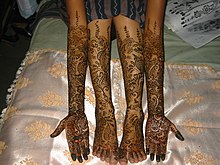Mehndi

Mehndi or Mehendi ( Hindi मेहन्दी, mehndī) is the name for the artistic, ornamental body painting ( bodypainting ) with henna from northwest India , today's Pakistan . It is used for cosmetic and ritual purposes and has been known since ancient times. It is said to have its origin in Persia and from there spread to India , the Arabian Peninsula and North Africa. In India, Persia, the Arab core countries, Morocco , Mauritania , Tunisia, Egypt , Turkey and theSudan the bride receives an artistic painting with henna on her hands, possibly forearms and feet for the wedding on henna night . In Bangladesh , Kashmir and Sudan, the groom also receives a mehndi, but it is far less splendid than that of the bride.
Ever since stars like Madonna brought body paintings in the style of Indian mehndis into fashion in the late 1990s , the term henna tattoo has become common in German for this type of body painting , as they look similar to tattoos . In contrast to real tattoos, mehndis fade within two to three weeks, since with these only the constantly renewing upper skin ( epidermis ) is colored and not the color is applied subcutaneously as with tattoos .
From a medical point of view, henna is considered safe for body painting. However, by nature, henna only stains in red-brown shades and requires a long exposure time. For a black shade and quick coloring of the skin, the hair dye PPD ( p-phenylenediamine ) is usually added to the henna , which can trigger severe allergic reactions and lead to irreparable skin and liver damage. PPD is cheap and it is allowed on the European market to add up to six percent PPD to henna.
For this reason, doctors recommend to be suspicious and cautious if - not only in a holiday destination like India, Morocco or Tunisia, but also in Europe - black coloring "henna tattoos" and pastes are offered by "male artists" or cosmetic companies. A mostly unmistakable sign that PPD is being used is the assurance that the result will be permanently visible after half an hour or a full hour. For mehndis with pure henna, in contrast, you have to wait at least six to eight hours.
Web links
- Angelika Lohwasser : Henna in Sudan. In: Mitteilungen der Sudanarchäologische Gesellschaft zu Berlin , issue 3, July 1995, p. 50f
- Collection Of Mehndi Designs Photo gallery of the English-speaking forum for Mehndi lovers and artists
Individual evidence
- ↑ Björn M. Hausen, Martin Kaatz, Uta Jappe, Ulrike Stephan, Gunthram Heidbreder: Henna / p-phenylenediamine contact allergy: Serious dermatoses after henna tattoos . In: Deutsches Ärzteblatt 98, edition 27 of July 6, 2001, pp. A-1822, B-1564, C-1449

